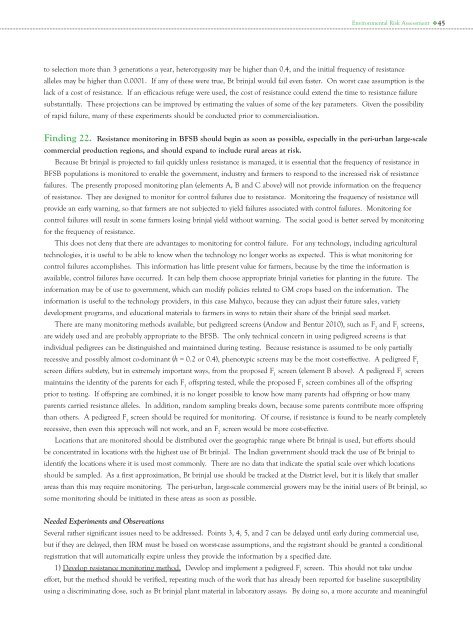Bt Brinjal The scope and adequacy of the GEAC environmental risk assessment
Bt Brinjal: The scope and adequacy of the GEAC ... - Down To Earth
Bt Brinjal: The scope and adequacy of the GEAC ... - Down To Earth
- No tags were found...
Create successful ePaper yourself
Turn your PDF publications into a flip-book with our unique Google optimized e-Paper software.
Environmental Risk Assessment 45to selection more than 3 generations a year, heterozygosity may be higher than 0.4, <strong>and</strong> <strong>the</strong> initial frequency <strong>of</strong> resistancealleles may be higher than 0.0001. If any <strong>of</strong> <strong>the</strong>se were true, <strong>Bt</strong> brinjal would fail even faster. On worst case assumption is <strong>the</strong>lack <strong>of</strong> a cost <strong>of</strong> resistance. If an efficacious refuge were used, <strong>the</strong> cost <strong>of</strong> resistance could extend <strong>the</strong> time to resistance failuresubstantially. <strong>The</strong>se projections can be improved by estimating <strong>the</strong> values <strong>of</strong> some <strong>of</strong> <strong>the</strong> key parameters. Given <strong>the</strong> possibility<strong>of</strong> rapid failure, many <strong>of</strong> <strong>the</strong>se experiments should be conducted prior to commercialisation.Finding 22. Resistance monitoring in BFSB should begin as soon as possible, especially in <strong>the</strong> peri-urban large-scalecommercial production regions, <strong>and</strong> should exp<strong>and</strong> to include rural areas at <strong>risk</strong>.Because <strong>Bt</strong> brinjal is projected to fail quickly unless resistance is managed, it is essential that <strong>the</strong> frequency <strong>of</strong> resistance inBFSB populations is monitored to enable <strong>the</strong> government, industry <strong>and</strong> farmers to respond to <strong>the</strong> increased <strong>risk</strong> <strong>of</strong> resistancefailures. <strong>The</strong> presently proposed monitoring plan (elements A, B <strong>and</strong> C above) will not provide information on <strong>the</strong> frequency<strong>of</strong> resistance. <strong>The</strong>y are designed to monitor for control failures due to resistance. Monitoring <strong>the</strong> frequency <strong>of</strong> resistance willprovide an early warning, so that farmers are not subjected to yield failures associated with control failures. Monitoring forcontrol failures will result in some farmers losing brinjal yield without warning. <strong>The</strong> social good is better served by monitoringfor <strong>the</strong> frequency <strong>of</strong> resistance.This does not deny that <strong>the</strong>re are advantages to monitoring for control failure. For any technology, including agriculturaltechnologies, it is useful to be able to know when <strong>the</strong> technology no longer works as expected. This is what monitoring forcontrol failures accomplishes. This information has little present value for farmers, because by <strong>the</strong> time <strong>the</strong> information isavailable, control failures have occurred. It can help <strong>the</strong>m choose appropriate brinjal varieties for planting in <strong>the</strong> future. <strong>The</strong>information may be <strong>of</strong> use to government, which can modify policies related to GM crops based on <strong>the</strong> information. <strong>The</strong>information is useful to <strong>the</strong> technology providers, in this case Mahyco, because <strong>the</strong>y can adjust <strong>the</strong>ir future sales, varietydevelopment programs, <strong>and</strong> educational materials to farmers in ways to retain <strong>the</strong>ir share <strong>of</strong> <strong>the</strong> brinjal seed market.<strong>The</strong>re are many monitoring methods available, but pedigreed screens (Andow <strong>and</strong> Bentur 2010), such as F 2<strong>and</strong> F 1screens,are widely used <strong>and</strong> are probably appropriate to <strong>the</strong> BFSB. <strong>The</strong> only technical concern in using pedigreed screens is thatindividual pedigrees can be distinguished <strong>and</strong> maintained during testing. Because resistance is assumed to be only partiallyrecessive <strong>and</strong> possibly almost co-dominant (h = 0.2 or 0.4), phenotypic screens may be <strong>the</strong> most cost-effective. A pedigreed F 1screen differs subtlety, but in extremely important ways, from <strong>the</strong> proposed F 1screen (element B above). A pedigreed F 1screenmaintains <strong>the</strong> identity <strong>of</strong> <strong>the</strong> parents for each F 1<strong>of</strong>fspring tested, while <strong>the</strong> proposed F 1screen combines all <strong>of</strong> <strong>the</strong> <strong>of</strong>fspringprior to testing. If <strong>of</strong>fspring are combined, it is no longer possible to know how many parents had <strong>of</strong>fspring or how manyparents carried resistance alleles. In addition, r<strong>and</strong>om sampling breaks down, because some parents contribute more <strong>of</strong>fspringthan o<strong>the</strong>rs. A pedigreed F 1screen should be required for monitoring. Of course, if resistance is found to be nearly completelyrecessive, <strong>the</strong>n even this approach will not work, <strong>and</strong> an F 2screen would be more cost-effective.Locations that are monitored should be distributed over <strong>the</strong> geographic range where <strong>Bt</strong> brinjal is used, but efforts shouldbe concentrated in locations with <strong>the</strong> highest use <strong>of</strong> <strong>Bt</strong> brinjal. <strong>The</strong> Indian government should track <strong>the</strong> use <strong>of</strong> <strong>Bt</strong> brinjal toidentify <strong>the</strong> locations where it is used most commonly. <strong>The</strong>re are no data that indicate <strong>the</strong> spatial scale over which locationsshould be sampled. As a first approximation, <strong>Bt</strong> brinjal use should be tracked at <strong>the</strong> District level, but it is likely that smallerareas than this may require monitoring. <strong>The</strong> peri-urban, large-scale commercial growers may be <strong>the</strong> initial users <strong>of</strong> <strong>Bt</strong> brinjal, sosome monitoring should be initiated in <strong>the</strong>se areas as soon as possible.Needed Experiments <strong>and</strong> ObservationsSeveral ra<strong>the</strong>r significant issues need to be addressed. Points 3, 4, 5, <strong>and</strong> 7 can be delayed until early during commercial use,but if <strong>the</strong>y are delayed, <strong>the</strong>n IRM must be based on worst-case assumptions, <strong>and</strong> <strong>the</strong> registrant should be granted a conditionalregistration that will automatically expire unless <strong>the</strong>y provide <strong>the</strong> information by a specified date.1) Develop resistance monitoring method. Develop <strong>and</strong> implement a pedigreed F 1screen. This should not take undueeffort, but <strong>the</strong> method should be verified, repeating much <strong>of</strong> <strong>the</strong> work that has already been reported for baseline susceptibilityusing a discriminating dose, such as <strong>Bt</strong> brinjal plant material in laboratory assays. By doing so, a more accurate <strong>and</strong> meaningful











